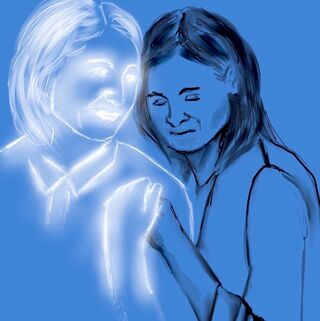Grief
Cold Cases, Psychics, and Grief
Psychics might exploit a void, but this can still benefit some grievers.
Posted September 22, 2021 Reviewed by Chloe Williams
Key points
- Unresolved murders can inspire survivors to consult psychics for information from the deceased.
- Searching for connection with the deceased can be part of the grieving process, yet it can also open grievers to exploitation.
- Bereavement counselors versed in the continuing bonds theory can affirm psychic readings while watching for signs of unhealthy attachment.

In July 1989, 17-year-old Kaitlyn Arquette was fatally shot in her car in Albuquerque, New Mexico. Police decided she was the victim of a random drive-by shooting. But her mother, successful YA author Lois Duncan, refused to accept this. She wanted to know what had actually happened, so she hired a private investigator and contacted journalists and psychics. She wrote about her experience in Who Killed My Daughter?
One famous psychic channeler held the earrings and necklace Kaitlyn had been wearing. She claimed to receive impressions of what the girl had experienced in her last moments and offered ideas about what she’d done that day. But this psychic didn’t identify a killer or produce a productive lead.
Another medium used automatic writing to invite Kaitlyn’s spirit to communicate. She told Duncan that Kait had known the person who shot her and was executed for being aware of a dangerous situation. Money had changed hands afterward. In an interview, Duncan said that a private investigator had verified this information. Suspicion pointed toward Kaitlyn's estranged boyfriend, who was allegedly involved in an insurance scheme. The pieces all fit. But he didn’t last long as a suspect and the crime wasn’t solved.
Duncan’s PI followed a lead on a man who’d been at the scene at the time, Paul Apodaca. Police knew about him but had never questioned him or even recorded his address. He’d been a security guard for the parking lot at what is now Central New Mexico Community College. His presence made sense, but the car seen with him at the scene had disappeared. He had no explanation. There was talk that he knew Kait’s boyfriend, but police didn't verify this. In 1995, Apodaca was arrested for rape.
Duncan had found the detectives resistant to the information she'd gathered. She set up a research center to help solve cold cases and continued her search for answers. When she passed away in 2016, the case remained unsolved. But this summer, there was a twist: In August, Apodaca confessed. Kaitlyn had been one of his three murders. He’d stabbed Althea Oakley in 1988 as she was walking home from a frat house party, and he’d shot Kaitlyn in her car the year after. It was random (or so he initially has said).
So, the psychics had been wrong. They’d given Duncan false hope of learning her daughter’s fate directly from her. Is this a good thing or a bad thing? The potential for exploiting a mother’s grief is evident, but might there nevertheless be a benefit? Bereavement counselors should consider this question.
Does After-Death Communication Help People Cope?
There’s little research on whether consulting a psychic during desperate grief does more harm than good, but the model of continuing bonds theory (CB) affirms a continued relationship with the deceased. Beishel, Mosher, and Boccuzzi (2015) hold that a belief that there might be after-death communication (ADC) appears to help. Often, ADCs derive from readings with psychic mediums who purport to act as channels to facilitate connection (called assisted ADC). It’s a popular pursuit for grieving people. They like to believe the loved one is still close by and might hear or speak to them.
Klass, Silverman, and Nickman (1996), who initiated the CB concept, had questioned traditional models of grief that applied linear formulas. The expectation was that people would pass through predictable grief tasks toward gaining healthy closure – as if there’s a one-size-fits-all way to endure significant loss. The CB researchers suggested a paradigm in which it is permissible, even normal, for the bereaved to continue their bond in a new way with a dead loved one. Remaining connected can provide comfort and a means for working through issues of guilt and adjustment. There’s no reason why all grief must resolve in acceptance, distancing, and moving on.
For some, continued bonds can mean acceptance of paranormal occurrences. They might suddenly see a specific type of bird or animal coming into their yard, have dreams about the loved one that seem real, feel the decedent’s presence during anniversaries, and interpret other signs as the lost loved one watching over them. It’s but a short step to consult a medium, especially when there’s a mystery about how the person died. The victims could have the best information, so if ADCs exist why not consult them?
However, Field (2006) thinks some CB expressions can be maladaptive, especially when there’s a lapse in monitoring one’s own reasoning. The griever can get stuck in an unhealthy emotional cycle or even believe the decedent is not really dead. Field recognizes that persistent attachment to the deceased allows the preservation of one’s sense of identity but says the nature of the postmortem bond should be qualitatively different than in life. That is, the living should accept the boundary between life and death. “From an attachment perspective, resolution of mourning is marked by termination of search behavior in recognizing the ‘impossibility’ of finding the lost figure and reorientation to everyday life…”
People who lose loved ones to murder become vulnerable to those who promise answers via ADCs. While such connection with the deceased can help to cope, it can also foster unhealthy responses. Grief counselors need to stay alert to signals for when attachment to afterlife notions has evolved from a beneficial bond into something negative.
References
Beischel, J., Mosher, C., & Boccuzzi, M. (2014-15). The possible effects on bereavement of assisted after-death communication during readings with psychic mediums: a continuing bonds perspective. Omega, 70(2), 169-94. doi: 10.2190/OM.70.2.b.
Field, N. P. (2006). Unresolved Grief and continuing bonds: An attachment perspective. Death Studies, 30, 739-756.
Klass, D., Silverman, P. R., & Nickman, S. (1996). Continuing bonds: New understandings of grief. Washington, DC: Taylor and Francis.




